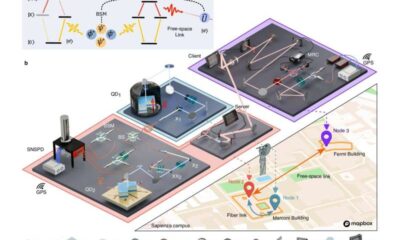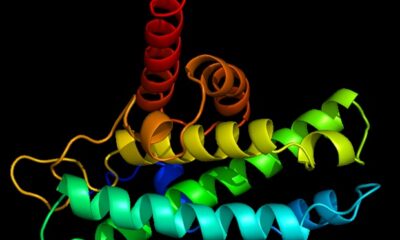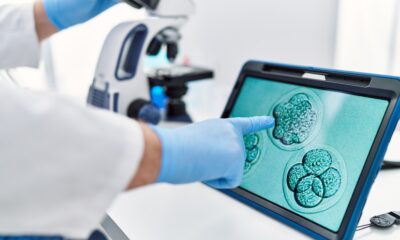Science
Researchers Develop Bacteria-Based Sensors for Water Contaminants

Researchers at Rice University have created genetically modified E. coli bacteria that function as living sensors, capable of detecting environmental toxins such as arsenite and cadmium in real time. This groundbreaking advancement enables the simultaneous monitoring of multiple contaminants and could significantly enhance water quality assessments in various settings, including pipelines and industrial sites.
A study detailing this innovation was published in Nature Communications on July 29, 2025. Led by scientists Xu Zhang, Marimikel Charrier, and Caroline Ajo-Franklin, the research addresses limitations found in current bioelectronic sensors, which typically require separate communication channels for each type of toxin. By leveraging the natural adaptability of bacteria, the team has developed a more efficient method of detection that could transform environmental monitoring.
Multiplexing Strategy Revolutionizes Detection
Traditionally, bioelectronic sensors rely on engineered bacteria that generate electrical signals in response to specific contaminants. However, each toxin usually requires its own unique strain, leading to inefficiencies. Inspired by fiber-optic technology, the researchers designed a system that uses varying redox potentials—essentially different energy levels—to convey multiple signals through a single sensor.
“This system represents a major leap in bioelectronic sensing, encoding multiple signals into a single data stream and decoding that data into multiple, clear yes-or-no readouts,” explained Ajo-Franklin, the corresponding author and the Ralph and Dorothy Looney Professor of Biosciences.
The research team developed an electrochemical method to isolate redox signatures and convert them into binary responses that signify the presence or absence of each toxin. Their approach combines synthetic biology with electrochemical analysis, allowing the engineered E. coli to interact specifically with either arsenite or cadmium, producing distinct electrical responses.
Real-Time Monitoring and Future Applications
The multiplexed sensors successfully detected arsenite and cadmium at levels compliant with standards set by the Environmental Protection Agency (EPA). This capability is crucial, especially given the enhanced risk posed by the presence of both metals, which can exhibit synergistic toxic effects.
“This system allows us to detect combined hazards more efficiently and accurately,” said Charrier, a bioengineering senior research specialist involved in the study. “Moreover, because the platform is modular, it could be scaled up to screen for more or different toxins simultaneously.”
The implications of this technology extend beyond heavy metal monitoring. Integrating wireless technologies could facilitate real-time surveillance of water systems, pipelines, and industrial sites. Additionally, the bioelectronic framework suggests potential future applications in biocomputing, wherein engineered cells might not only sense and store environmental data but also process and transmit it through electronic interfaces.
As the field of bioelectronics advances, this research serves as a foundational step towards developing intelligent, self-powered biosensor networks. The team envisions multiplexed, wireless bacterial sensors becoming vital tools for environmental monitoring, diagnostics, and biocomputational tasks, all powered by microorganisms.
“A key advantage of our approach is its adaptability; we believe it’s only a matter of time before cells can encode, compute, and relay complex environmental or biomedical information,” Ajo-Franklin concluded.
This innovative research highlights the potential of bioengineering in addressing environmental challenges and sets the stage for a future where biotechnology plays an integral role in safeguarding water quality.
-

 World3 days ago
World3 days agoCoronation Street’s Shocking Murder Twist Reveals Family Secrets
-

 Entertainment4 months ago
Entertainment4 months agoKate Garraway Sells £2 Million Home Amid Financial Struggles
-

 Entertainment3 months ago
Entertainment3 months agoAnn Ming Reflects on ITV’s ‘I Fought the Law’ Drama
-

 Health3 months ago
Health3 months agoKatie Price Faces New Health Concerns After Cancer Symptoms Resurface
-

 Entertainment3 weeks ago
Entertainment3 weeks agoCoronation Street Fans React as Todd Faces Heartbreaking Choice
-

 World4 weeks ago
World4 weeks agoBailey Announces Heartbreaking Split from Rebecca After Reunion
-

 Entertainment6 days ago
Entertainment6 days agoTwo Stars Evicted from I’m A Celebrity Just Days Before Finale
-

 World6 days ago
World6 days agoKevin Sinfield Exceeds Fundraising Goal Ahead of Final Marathons
-

 Entertainment3 months ago
Entertainment3 months agoCoronation Street’s Carl Webster Faces Trouble with New Affairs
-

 Entertainment3 months ago
Entertainment3 months agoWhere is Tinder Swindler Simon Leviev? Latest Updates Revealed
-

 Entertainment4 months ago
Entertainment4 months agoMarkiplier Addresses AI Controversy During Livestream Response
-

 Science2 months ago
Science2 months agoBrian Cox Addresses Claims of Alien Probe in 3I/ATLAS Discovery





















